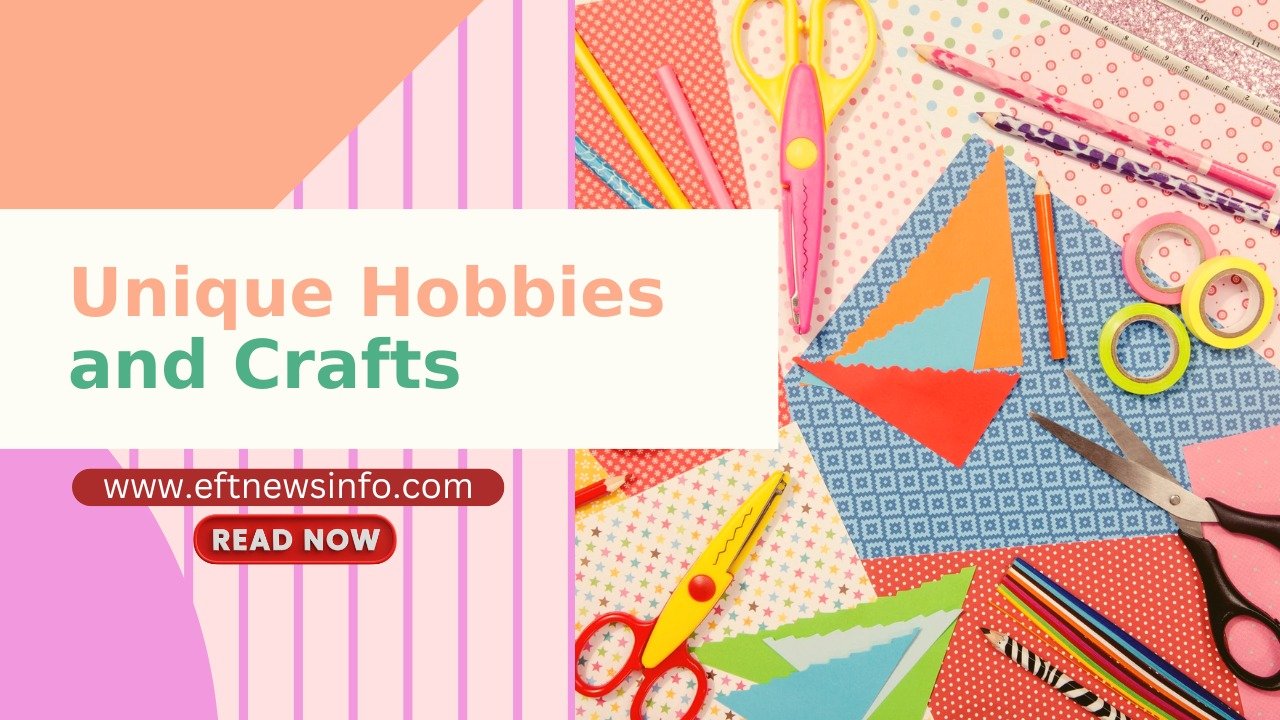In our fast-paced world, it’s easy to get caught up in the hustle and bustle of daily life, leaving little room for creativity and relaxation. However, engaging in artistic hobbies and crafts can be a wonderful way to unwind, express yourself, and discover hidden talents. Whether you’re a seasoned artist or a complete beginner, there are countless unique hobbies and crafts to explore that can reignite your creative spark. This blog post will delve into some fascinating activities that you can start today to unleash your inner artist.
Table of Contents
1. Fluid Art : Unique Hobbies and Crafts
What is Fluid Art?
Fluid art, also known as paint pouring, is a form of abstract art that involves pouring paints directly onto a canvas to create beautiful, swirling patterns. This technique allows the paint to flow and blend naturally, resulting in stunning, one-of-a-kind pieces.
Getting Started
To begin with fluid art, you’ll need a few basic supplies: acrylic paints, a pouring medium, canvases, and some plastic cups for mixing. The pouring medium helps the paint flow more easily and prevents it from cracking once it dries. Start by mixing your paints with the medium, then pour them onto the canvas in whatever way you like. Tilt the canvas to let the paint spread and watch as mesmerizing designs emerge.
Tips for Success
- Experiment with colors: Don’t be afraid to mix different colors and see how they interact. Metallic and neon paints can add extra flair to your pieces.
- Use a clean workspace: Fluid art can get messy, so cover your workspace with plastic or newspaper to make cleanup easier.
- Practice patience: Allow your artwork to dry completely before moving it. This can take anywhere from 24 to 48 hours.
2. Hand Lettering and Calligraphy
What is Hand Lettering?
Hand lettering is the art of drawing letters, as opposed to writing them. It encompasses a variety of styles, from elegant calligraphy to modern, playful scripts.
Getting Started
To start hand lettering, you’ll need paper, pens, and pencils. For calligraphy, a dip pen and ink or brush pens are essential. There are plenty of online tutorials and books available that can guide you through the basics of different lettering styles.
Tips for Success
- Practice regularly: Hand lettering requires practice to develop muscle memory and control. Set aside time each day to practice.
- Use guidelines: Lightly pencil in guidelines on your paper to keep your letters even and consistent.
- Be patient with yourself: It’s normal to make mistakes. Embrace them as part of the learning process.
3. Resin Art
What is Resin Art?
Resin art involves using epoxy resin—a clear, glossy substance—to create beautiful, glass-like artwork. Artists often embed objects like flowers, shells, or glitter into the resin for added depth and interest.
Getting Started
For resin art, you’ll need epoxy resin, hardener, molds (if creating 3D objects), and safety gear like gloves and a mask. Mix the resin and hardener according to the instructions, then pour it into your mold or onto a surface. Add your chosen embellishments and let it cure.
Tips for Success
- Work in a well-ventilated area: Resin can emit fumes, so ensure you have good ventilation or wear a mask.
- Measure accurately: The ratio of resin to hardener must be precise to ensure proper curing.
- Experiment with layers: Create depth by pouring resin in layers, embedding objects at different levels.
4. Macramé
What is Macramé?
Macramé is a crafting technique that uses knotting to create intricate patterns and designs. It’s often used to make wall hangings, plant hangers, and jewelry.
Getting Started
To start macramé, you’ll need cord or rope and a dowel or ring to anchor your work. Learn basic knots like the square knot and the half hitch, which are the foundation of many macramé projects.
Tips for Success
- Start simple: Begin with small projects to practice your knots before moving on to larger pieces.
- Keep tension consistent: Ensure your knots are tight and even for a polished look.
- Use quality materials: High-quality cord will result in a more durable and attractive finished product.
5. Pottery and Ceramics
What is Pottery?
Pottery involves shaping clay into functional or decorative items and then firing them in a kiln. This ancient art form allows for endless creativity, from sculpting intricate figures to throwing pots on a wheel.
Getting Started
To try pottery, you’ll need clay, basic sculpting tools, and access to a kiln. Many community centers and art schools offer classes where you can learn the basics and use their facilities.
Tips for Success
- Be patient: Working with clay can be challenging at first. Take your time to learn the techniques.
- Keep your clay moist: Dry clay is difficult to work with, so keep it covered when not in use.
- Experiment with glazes: Different glazes can produce a variety of effects, so don’t be afraid to try new combinations.
6. Glassblowing
What is Glassblowing?
Glassblowing is the art of shaping molten glass into objects by blowing air through a tube. This fascinating craft can produce everything from delicate ornaments to robust sculptures.
Getting Started
Glassblowing requires specialized equipment, including a furnace, blowpipe, and various tools for shaping the glass. Many studios offer beginner workshops where you can try your hand at this craft under the guidance of experienced instructors.
Tips for Success
- Wear protective gear: Safety is paramount when working with hot glass, so always wear protective gloves and eyewear.
- Work with a partner: Glassblowing often requires teamwork, so having a partner can make the process smoother and safer.
- Practice control: Learning to control the airflow and temperature is crucial for shaping the glass accurately.
7. Embroidery and Cross-Stitch
What is Embroidery?
Embroidery involves decorating fabric with needle and thread to create intricate patterns and designs. Cross-stitch is a type of embroidery that uses X-shaped stitches to form a picture or pattern.
Getting Started
To start embroidery or cross-stitch, you’ll need fabric, embroidery floss, needles, and an embroidery hoop. Choose a simple pattern to begin with and practice your stitches.
Tips for Success
- Use good lighting: Working with small stitches can be straining on the eyes, so ensure you have adequate lighting.
- Keep your fabric taut: An embroidery hoop helps keep your fabric stretched and makes stitching easier.
- Follow a pattern: Start with pre-printed patterns or downloadable templates to guide your work.
8. Woodworking
What is Woodworking?
Woodworking involves creating items from wood, ranging from small carvings to large furniture pieces. This versatile craft allows you to build functional and decorative items.
Getting Started
For woodworking, you’ll need basic tools like a saw, hammer, chisels, and sandpaper. As you advance, you may want to invest in power tools for more complex projects. There are numerous online tutorials and local classes that can teach you the basics.
Tips for Success
- Measure twice, cut once: Accurate measurements are crucial in woodworking to ensure your pieces fit together properly.
- Choose the right wood: Different woods have different properties, so select the right type for your project.
- Sand and finish: Proper sanding and finishing can elevate the quality of your finished piece, giving it a professional look.
9. Origami
What is Origami?
Origami is the traditional Japanese art of paper folding. It involves creating intricate designs and figures from a single sheet of paper without using cuts or glue.
Getting Started
All you need to start origami is a square piece of paper. There are countless books and online resources with step-by-step instructions for a variety of origami designs.
Tips for Success
- Use precise folds: Accuracy is key in origami, so take your time to make precise folds.
- Start simple: Begin with easier designs before tackling more complex models.
- Be patient: Origami can be challenging, but patience and practice will lead to beautiful results.
10. Candle Making
What is Candle Making?
Candle making involves creating candles from wax, wicks, and various additives like scents and dyes. This craft allows you to customize candles to your taste and make perfect gifts.
Getting Started
To start candle making, you’ll need wax (such as soy, beeswax, or paraffin), wicks, a melting pot, and molds. You can also add scents and dyes to personalize your candles.
Tips for Success
- Monitor temperatures: Proper temperature control is crucial for melting and pouring wax.
- Secure your wick: Ensure the wick is centered and secured in the mold before pouring the wax.
- Experiment with scents: Combine different essential oils to create unique and pleasing aromas.
11. Leather Crafting
What is Leather Crafting?
Leather crafting involves creating items from leather, such as wallets, belts, bags, and more. This craft combines practicality with creativity, resulting in durable and beautiful items.
Getting Started
To begin leather crafting, you’ll need leather, cutting tools, needles, thread, and patterns. Starter kits are available that include all the necessary tools and materials.
Tips for Success
- Use quality leather: High-quality leather will yield better results and a more professional finish.
- Learn basic techniques: Techniques like cutting, stitching, and finishing are fundamental to leather crafting.
- Practice makes perfect: As with any craft, practice will improve your skills and confidence.
FAQ
What makes these hobbies and crafts unique?
These hobbies and crafts offer a distinct blend of creativity, expression, and hands-on engagement. Unlike mainstream activities, they encourage individuals to explore unconventional mediums and techniques, resulting in truly one-of-a-kind creations.
Are these hobbies suitable for beginners?
Yes, many of these hobbies cater to beginners and seasoned artists alike. With ample online resources, tutorials, and beginner-friendly projects, individuals can easily start their creative journey, regardless of their skill level or prior experience.
How can I incorporate these activities into my daily life?
These hobbies and crafts can be seamlessly integrated into your routine, whether you dedicate specific time slots for creative exploration or incorporate them into moments of relaxation. They offer a therapeutic escape from the stresses of everyday life while allowing you to cultivate new skills and passions.

